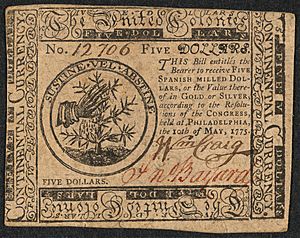Second Continental Congress facts for kids
Quick facts for kids Second Continental Congress |
|
|---|---|
| Part of the American Revolution | |

Congress Voting Independence by Robert Edge Pine
|
|
| Type | |
| Type | |
| History | |
| Established | May 10, 1775 |
| Disbanded | March 1, 1781 |
| Preceded by | First Continental Congress |
| Succeeded by | Congress of the Confederation |
| Leadership | |
|
Secretary
|
|
| Seats | Variable; ~60 |
| Meeting place | |
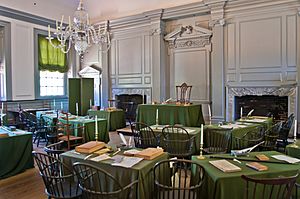 |
|
| Assembly Room, Pennsylvania State House, Philadelphia, Pennsylvania Under exigent circumstance also met at: Henry Fite House, Baltimore, Maryland; Court House, Lancaster, Pennsylvania; Court House, York, Pennsylvania; College Hall, Philadelphia, Pennsylvania |
|
The Second Continental Congress was a very important meeting of leaders from the Thirteen Colonies in the late 1700s. These leaders came together to support the American Revolution and the war that helped the American colonies become free from the British Empire. This Congress created a new country, first called the United Colonies, and then in 1776, it was renamed the United States of America. The Congress started meeting in Philadelphia on May 10, 1775, soon after the first battles of the war at Battles of Lexington and Concord.
The Second Continental Congress followed the First Continental Congress, which had met earlier in Philadelphia. The Second Congress acted like the first national government for the new country during the Revolutionary War. It helped create armies, planned war strategies, sent diplomats to other countries, and wrote important letters like the Declaration of the Causes and Necessity of Taking Up Arms and the Olive Branch Petition. All 13 colonies were represented when the Congress voted for the Lee Resolution, which declared independence from Britain on July 2, 1776. Two days later, the Congress fully agreed to the Declaration of Independence.
The Congress served as the temporary government of the United States until March 1, 1781. During this time, it successfully managed the war, wrote the first U.S. constitution called the Articles of Confederation, got support from other countries, and helped settle land claims in the western parts of the country. Many of the people who attended the Second Congress had also been part of the First. They chose Peyton Randolph as their president again and Charles Thomson as secretary. New important members included Benjamin Franklin from Pennsylvania and John Hancock from Massachusetts.
After two weeks, Randolph had to return to Virginia. John Hancock then became the president, and Thomas Jefferson took Randolph's place in the Virginia group. More colonies joined too, as Georgia officially supported the Congress in July 1775.
Contents
How the Congress Began to Lead
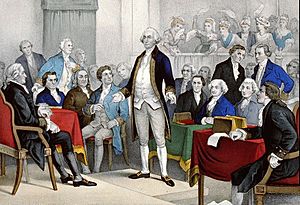
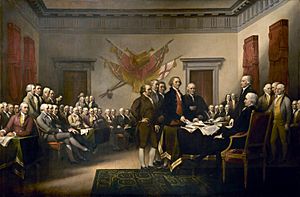
The First Continental Congress had asked King George III to stop the unfair Intolerable Acts. They also created the Continental Association to organize protests and boycott British goods. The Second Continental Congress met on May 10, 1775, to plan what to do next if Britain didn't change its laws. However, the American Revolutionary War had already begun with the Battles of Lexington and Concord. So, the Congress had to take charge of the war effort right away.
For the first few months of the war, the Patriots fought in a disorganized way. Still, they had many successes. They took over British weapon storage places and forced royal officials out of several colonies. They also started the Siege of Boston to stop British troops from moving by land. On June 14, 1775, the Second Continental Congress voted to create the Continental Army. This army was formed from the local militia groups around Boston. The next day, they all agreed to name George Washington from Virginia as the army's commanding general.
On July 6, 1775, Congress approved a Declaration of Causes. This document explained why the colonies felt it was necessary to fight. Two days later, the delegates signed the Olive Branch Petition to King George III. In this petition, they said they were still loyal to the king and asked him to prevent more fighting. However, by the time the petition reached Britain, King George III had already declared the colonies to be in "open rebellion." Because of this, the king refused to even read the petition.
Georgia had not sent delegates to the First Continental Congress. At first, they didn't send delegates to the Second Congress either. But as the war grew, people from St. John's Parish in Georgia sent Lyman Hall to the meeting. He could join in discussions but couldn't vote, as he didn't represent the whole colony. This changed in July 1775 when Georgia decided to send full delegates and join the trade ban against Britain.
The Continental Congress didn't have official legal power from Britain to govern. But it took on all the jobs of a national government. This included sending ambassadors, signing treaties, raising armies, choosing generals, getting loans from Europe, and printing money called "Continentals." The Congress could not collect taxes. It had to ask the states for money, supplies, and soldiers to support the war. Often, individual states did not provide what was asked.
Steps Toward Independence
In 1776, Congress began moving toward declaring independence from the British Empire. However, many delegates did not have permission from their home colonies to take such a big step. Those who wanted independence worked to get their colonial governments to change their minds. Some even tried to replace governments that wouldn't agree to independence. On May 10, 1776, Congress passed a resolution. It suggested that any colony without a government that supported independence should form one that did.
On May 15, they added a stronger statement to this resolution. It was written by John Adams. This statement advised colonies to stop being loyal to the British Crown. It also suggested removing the Crown's power from any colonial government that still got its authority from the king. On the same day, the Virginia Convention told its delegates in Philadelphia to propose a resolution. This resolution called for a declaration of independence, forming alliances with other countries, and creating a union of the states. The vote for independence was delayed for several weeks. This gave supporters of independence time to gather more support in their home colonies.
On June 7, 1776, Richard Henry Lee presented a resolution to Congress. It declared the colonies independent. He urged Congress to "take the most effectual measures for forming foreign Alliances" and to prepare a plan for a confederation of the new states. Lee argued that independence was the only way to get help from other countries. No European kings would deal with America if it remained a British colony. American leaders had rejected the idea of kings ruling by "divine right." But they knew they needed to show they were serious to the rest of the world.
Congress officially adopted the resolution of independence on July 2, 1776. Before this, they created three committees. These committees were to write the Declaration of Independence, a model treaty for foreign alliances, and the Articles of Confederation. The Declaration announced the new states joining the world stage. The model treaty was for friendly trade with other countries. The Articles of Confederation created a "firm league" among the thirteen free and independent states. Together, these three documents set up the first central government for the new country. After approving the independence resolution, Congress focused on explaining their decision. The United States Declaration of Independence was approved on July 4 and published soon after.
Leading During the War
The Congress had to move to Baltimore in the winter of 1776–77. This was to avoid being captured by British forces who were moving towards Philadelphia. Henry Fite's tavern was the biggest building in Baltimore then. It was large enough for Congress to meet comfortably. Its location was also safe from British ships that might try to attack the town. Congress was forced to leave Philadelphia again in September 1777. British troops took over the city. The Congress moved to York, Pennsylvania, where they continued their work.
Congress passed the Articles of Confederation on November 15, 1777. This happened after more than a year of discussions. They then sent it to the states for ratification, which means official approval. All 13 states had to approve it for it to become the country's first constitution. One idea for a Senate (to represent states) and a House (to represent people) was rejected then. However, a similar idea was used later in the United States Constitution.
One big discussion was about how much power larger states should have. Smaller states worried that larger states would have too much control. The small states won, and each state got one vote. Another debate was about western land claims. States without land claims in the west wanted those with claims to give them to Congress. In the end, western land claims stayed with the individual states. Congress urged the states to approve the Articles quickly, and most did. Virginia was the first to approve it on December 16, 1777. By February 1779, 12 states had approved the Articles. Maryland was the last holdout. It finally approved the Articles on February 2, 1781. This happened only after Virginia gave up its claims to land north of the Ohio River to Congress.
Meeting Locations and Leaders
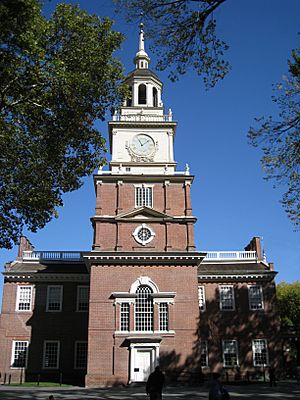
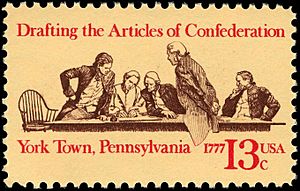
| May 10, 1775 – December 12, 1776 | |
|---|---|
| Location: | Pennsylvania State House, Philadelphia, Pennsylvania |
| President: | Peyton Randolph (until May 24, 1775) John Hancock (from May 24, 1775) |
| December 20, 1776 – February 27, 1777 | |
|---|---|
| Location: | Henry Fite House, Baltimore, Maryland |
| President: | John Hancock |
| March 5, 1777 – September 18, 1777 | |
|---|---|
| Location: | Pennsylvania State House, Philadelphia, Pennsylvania |
| President: | John Hancock |
| September 27, 1777 | |
|---|---|
| Location: | Court House, Lancaster, Pennsylvania |
| President: | John Hancock |
| September 30, 1777 – June 27, 1778 | |
|---|---|
| Location: | Court House, York, Pennsylvania |
| President: | John Hancock (until October 29, 1777) Henry Laurens (from November 1, 1777) |
| July 2, 1778 – July 20, 1778 | |
|---|---|
| Location: | College Hall, Philadelphia |
| President: | Henry Laurens |
| July 21, 1778 – March 1, 1781 | |
|---|---|
| Location: | Pennsylvania State House, Philadelphia, Pennsylvania |
| President: | Henry Laurens (until December 9, 1778) John Jay (from December 10, 1778, until September 28, 1779) Samuel Huntington (from September 28, 1779) |
See also
 In Spanish: Segundo Congreso Continental para niños
In Spanish: Segundo Congreso Continental para niños
- American Revolutionary War#Prelude to revolution
- Founding Fathers of the United States
- History of the United States (1776–1789)
- List of delegates to the Continental Congress
- Memorial to the 56 Signers of the Declaration of Independence
- State cessions
- Timeline of the American Revolution
- United Colonies


